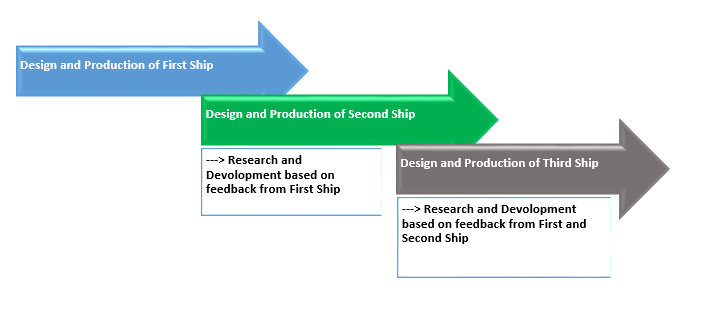If you haven't read the Part-One, click on the it to get a very brief introduction about the bulbous bow.
In the following part we shall be discussing about how it helps in reducing drag and what are the requirements to have a bulb.
To understand with the working of the bulb we need to know about the various types of waves generated by the ships.
There are generally two types of waves generated by the ship,
- Divergent Waves: originated at the sides of the ship and have crests inclined in relation to the symmetry plane of the ship.
- Transverse Waves: originated at the ford and aft part of the ship and have crests perpendicular to the symmetry plane of the ship.
The interference between these wave systems originates the characteristics humps & hollows as a function of the ratio (Vs/Lwl) of the ship. This is where the Bulbous Bow comes into picture, the wave system generated by the bulb interferes with the wave system of the ship resulting in ideally no waves, practically smaller bow divergent waves. The length of the bulb defines the phase of interference and its volume determines the width of its bow system.

However, the efficiency of the bulb lies in that narrow range of speed for which it is designed for. At low speed a Bulbous Bow will trap water above the bulb without forming a low pressure zone to cancel the bow wave. This leads to increased drag and loss of efficiency. Each design has what is known as most efficient hull speed, or often just hull speed. This term refers to the speed where the shape of the hull is acting on the water in such a way to produce minimum possible drag.
The ideal hull speed may not be the top speed of a ship because at some point the lower pressure zone created by the bow features become larger than necessary. A zone of lower pressure water that is larger than the hull is insufficient and leads to reduced rudder response.
Ideally the cone of lower pressure will collapse just before the propeller and this would lead to a phenomenon of cavitation, this leads to reduced efficiency of the propeller, sluggish steering, and excessive wear of hull and drive components.
Now the biggest question arises Who Can and Who Can't?
It is generally observed that vessels under 49 feet(15 m) do not have enough wetted surface area. The structure of bulb also increases drag and at a certain point the benefits shrink to zero. Conversely, larger ships with a high proportion of waterline to frontal area use the bulbous bow most effectively. Another factor that determines the use of bulb is the cost to benefit ratio. LSD
Author's Note: This article is the second part of the topic 'What's with the Bulb?'. It expounds to us about the working of the bulb and what are the favorable situations to use the bulb effectively. In the next and the final part of the series we will be discussing about the various sections of the bulb, few design factors and followed by advantages and disadvantage of having a bulbous bow. I have written this article based on my experience and technical knowledge on the same as a Naval Architect. The picture used above does not belong to LSD, and full credit for the same goes to their respective owners. If you have any queries or doubts, write to me at learnshipdesign@gmail.com


















